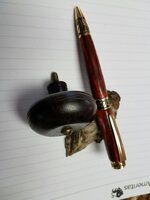jbg230
Member
Took out a cocobolo blank from my drawer today to make a cigar pen. I bought the blank from a leading vendor. I thought I got lucky since the blank was a beautiful reddish/orangey brown with nice grain. Exactly why I chose this species.
Before I got the blank to round on the lathe, I noticed that the nice tone had disappeared and I was left with a dull greyish brown color. By the time I finished, I had managed to have a nice looking pen, but in reality it was just average in terms of color. A common brown. Still a nice pen since the grain is appealing, but I didn't expect such a dramatic difference in the loss of the red/orange.
So I have to wonder; could it be that a vendor would apply a stain or dye to the wood which only enhances the outward appearance of a blank? Certainly, as I have posted recently, that you never quite know what you'll wind up with as you get down to the bushings, but this change in color so quick in the turning process had me questioning.
Before I got the blank to round on the lathe, I noticed that the nice tone had disappeared and I was left with a dull greyish brown color. By the time I finished, I had managed to have a nice looking pen, but in reality it was just average in terms of color. A common brown. Still a nice pen since the grain is appealing, but I didn't expect such a dramatic difference in the loss of the red/orange.
So I have to wonder; could it be that a vendor would apply a stain or dye to the wood which only enhances the outward appearance of a blank? Certainly, as I have posted recently, that you never quite know what you'll wind up with as you get down to the bushings, but this change in color so quick in the turning process had me questioning.
Last edited:

